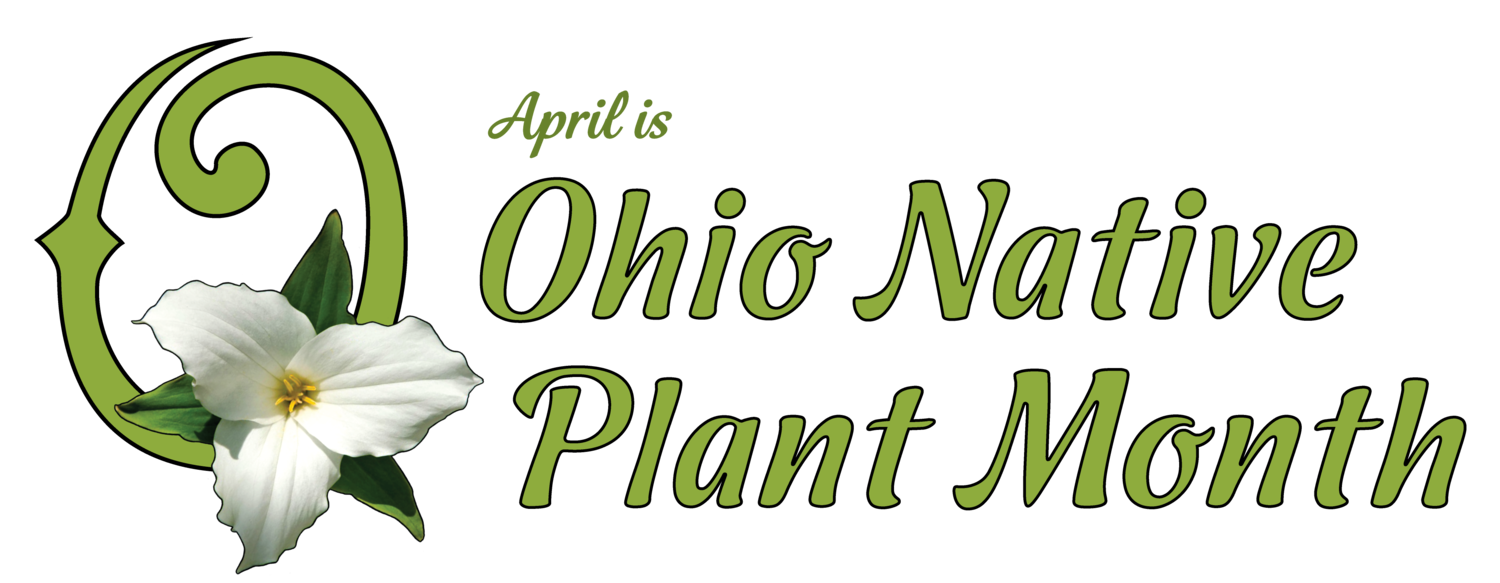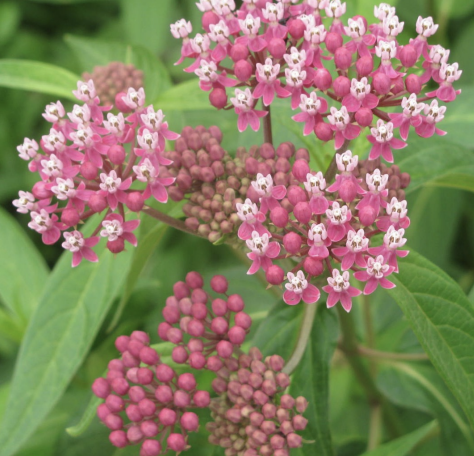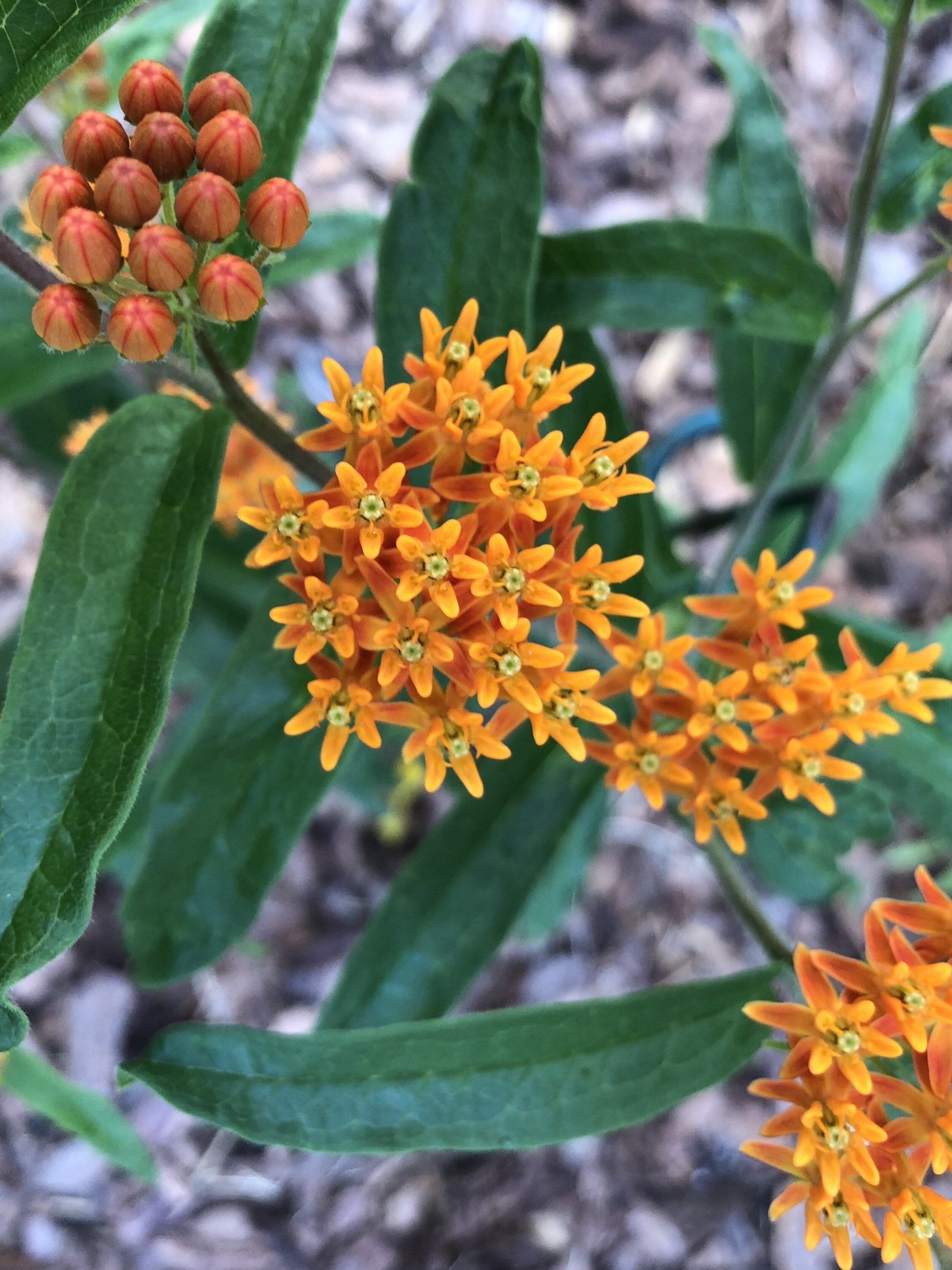Plant a Pollinator Garden in 2025!
Replace an area of lawn with a garden full of colorful native plants for pollinators!
Why Replacing Lawn with Native Gardens is Important
Lawns require mowing, feeding with fertilizer, treating for insects and funguses, watering during droughts, aerating, over-seeding and more. They provide no nectar or pollen for bees, no food for butterflies, native birds, or insects, and no shelter for wildlife.
If every homeowner, organization, and business replaces a sunny area of lawn with a garden to support pollinators and wildlife, the cumulative impact across Ohio will make a difference!
Install a small pocket garden for pollinators in 2025!
Butterfly Weed (Asclepias tuberosa)
Seeds or Plants?
You may want to create a pollinator garden using native plants in containers, or you may want to use seeds. If you choose to use container plants, visit our website page titled, “Where to Buy Native Plants, “ to find a native plant source near you. If you would like to use seed, please read below.
A New Pollinator Plant Seed Mix for Small Pocket Pollinator Gardens!
OPN Seed (an Ohio company) has worked with us to create a special blend of seed for creating a Pocket Pollinator Garden (PPG). This unique blend consists of seeds from 28 native plants, all selected to grow in full sun, only getting about three feet in height (a short mix), packed with flowering plants for lots of color and to help pollinators, with a few native mint plants to help discourage deer, and three species of butterfly weed (Asclepias) to meet the requirements for a Monarch Way-Station.
Pictures of all 28 plants used in our Pocket Pollinator Garden seed mix can be found at the bottom of this page
Buying Seed
1) To buy a Packet of Seed that will cover 250 square feed (about 16’ x 16’), please click below:
2) To buy bulk seed to cover 1/10 acre, 1/4 acre, 1/2 acre, or 1 acre please click below:
How To Install a Pocket Pollinator Garden
1) Select the site
Choose an area in the full sun where you would like your garden. One packet of seed will cover 250 square feet (about 16’ x 16’), or bulk seed is available, so your garden could be small to very large. Select a dry, sunny, generally flat spot with reasonable soil. Use a hose, rope or string to lay out the shape of your bed.
2) When Can I Plant?
Seed from this mix can be planted in the late fall, anytime during the winter, early spring, or as late as early June. The ONLY BAD TIME to plant seed is during the hot dry months of the summer.
Garden site (Photo: OPN Seed)
3) Preparing the Site
Remove any rocks or debris from the area. If lawn is present, either mow it as low as possible or use a string-trimmer to remove the lawn down to the soil. There is no need to till the soil, and if possible, please do not spray with chemicals to kill the plants in this area.
4) Laying the Garden Foundation
Paper: Cover the garden area with cardboard, or multiple layers of newspaper. If it’s windy, spray the newspaper with water to help keep it in place. Once down, wet the cardboard or newspaper so that it makes good contact with the soil. This paper layer forms a barrier that will help suppress weeds from growing up from underneath.
Mulch: Cover the paper layer with 3-5 inches of aged, clean, pine fines, very small pine bark nuggets, or 50% shredded top soil mixed with 50% pine fines, leaf mold, and/or compost (do not use just top soil). Make sure the mulch is CLEAN (no dyes or chemicals to control weeds, and no weed seeds). It’s best if the mulch has been sitting around for a few years and has decomposed a bit, but weed-free compost or triple-shredded hardwood mulch (without dye or chemicals) can be used.
Cardboard covering planting area (Photo: OPN Seed)
Mulch covering cardboard (Photo: OPN Seed)
Seed mixed in rice hulls (Photo: ONP Seed)
Lightly raking seed into mulch (Photo: OPN Seed)
5) Seeding the Garden
Seeding: Now that the site has been prepared, it’s time to seed! Many of the seeds in our Pocket Pollinator Garden mix are extremely small, almost like dust. To help you spread your seeds more evenly across the garden, it helps to use a “carrier.” If you mix your seed in a bucket of rice hulls or clean playground sand, it will make it much easier to distribute the seed evenly over the area. Once mixed, take hand-fulls of seed/carrier mix and broadcast/throw them across your garden. The carrier will allow you to see where you have seeded, and where more seed is needed.
Raking: Now that the seed has been dispersed across the garden, take a garden/soil rake and gently rake into the top 1/4 inch. Native seeds prefer to be near the surface of the soil, so the goal here is to help the seed make good soil contact with minimal disturbance.
6) Register Your Garden (This is Important!)
Now that you have installed your Pocket Pollinator Garden, please register your garden with these organizations:
Home Grown National Park: Dr. Doug Tallamy, Professor of Behavioral Ecology at the University of Deleware, it keeping track of the square footage of land in the United States dedicated to native plants. PLEASE visit his website to share the amount of area you or your organization is dedicating to native plants.
Monarch Watch: Since our seed mix contains at least three species of Butterfly Weed (Asclepias), please click on this link to register your garden with Monarch Watch as a Monarch Waystation.
Plant for Pollinators: The Cincinnati Zoo & Botanical Garden is keeping track of the number of gardens that include plants for pollinators. Please register your garden with this organization.
7) What to Expect
The first growing season, you should start to see little plants sprouting in your garden. By the end of the summer, you may see a few of your little plants flower. Don’t be discouraged! When planting a garden from seed, the first year is typically very sparse since the seed is just waking up. The second year you typically see many more plants germinate and grow, and it’s not until the third year that your garden is full of wonderful, flowering native plants.
8) Adding Color and Attracting Pollinators Faster (Optional- for Spring Planting)
If you would like to see your garden filled with color and attracting pollinators during the first summer, we have developed another mix of seed called the Fast Color Seed Mix. This mix contains non-native annual plants: they will grow and flower all summer, and after the first hard freeze in the fall, they will die. The goal is to have a “cover crop” that will help to hold the mulch layer in place, add color to your garden faster, and will eventually die out to allow the native perennials to take over your garden by the third year. If you are installing a garden with children or in a very public place, adding this seed to your perennial mix might be a good option for faster impact. Note: Please wait until the danger of a late freeze or frost has passed to add this seed to your pollinator garden.
9) Maintenance
Once seeded, you may need to water occasionally during the first summer if it is very hot or we have a drought for several weeks. But once the plants are established, no water should be needed. And once mature, mowing this area once a year in the late spring with your mower on its highest setting is all it will need. Please wait until late Spring so that many of our native bees living in hollow garden stems are not harmed.
10) A New Type of Garden- Building Acceptance
Since the mid 1850’s there has been a steady increase in the number of exotic, non-native plants we have brought into the United States to fill our gardens. Having a well-manicured lawn and non-native plants has become the norm in many neighborhoods, and many organizations and homeowner associations expect this type of “look.” Now that we realize the importance of native plants for the survival of our fragile ecosystems and the health of the environment, acceptance of native plant gardens is growing.
To help your Pocket Pollinator Garden gain acceptance, there are several things you can do to help. Installing your garden as we have described in a bed of mulch will make your garden look more like a maintained, traditional garden. Edging the garden, adding stone or brick along the edge, or using a small fence will tell neighbors that this space is a planned garden space. Including a bird feeder or bird house in the middle of your garden will give it purpose. And including a sign indicating that your garden is part of Monarch Watch, or the HomeGrown National Park initiative, or an Ohio native plant garden will all help your garden to gain acceptance.
Seed Included in our Pocket Pollinator Garden Mix
Below are pictures and descriptions of each of the perennials included in our Pocket Pollinator Garden mix. The mix has been formulated to include a nice balance of all of these wonderful native plants. Please note that some plants will do better in some locations than others (north/south, wetter/dryer, windy/calm, acidic/alkaline, sandy/clay, etc). As a result some of the plants are apt to perform better than others in your garden, but with such a diverse selection of plants, every garden should contain a great selection of pollinator plants from this seed mix.
1) Western Yarrow (Achillea millefolium var. occidentalis):
Photo: Mary E. Lewis
2) Swamp Milkweed (Asclepias incarnata):
3) Showy Milkweed (Asclepias speciosa):
4) Butterfly Weed (Asclepias tuberosa):
Photo: OPN Seed
5) Smooth Aster (Aster laevis):
6) Canadian Milkvetch (Astragalus canadensis):
Photo: OPN Seed
7) Partridge Pea (Chamaecrista fasciculata):
Photo: OPN Seed
8) Lanceleaf Coreopsis (Coreopsis lanceolata):
Photo: OPN Seed
9) Plains Coreopsis (Coreopsis tinctoria):
Photo: OPN Seed
10) Purple Prairie Clover (Dalea purpurea):
Photo: OPN Seed
11) Purple Coneflower (Echinacea purpurea):
Photo: OPN Seed
12) Rattlesnake Master (Eryngium yuccifolium):
Photo: OPN Seed
13) Common Gaillardia (Gaillardia aristata):
Photo: OPN Seed
14) Indian Blanket (Gaillardia pulchella):
Photo: OPN Seed
15) Dense Blazingstar (Liatris spicata):
Photo: OPN Seed
16) Great Lobelia (Lobelia siphilitica):
17) Lemon Beebalm (Monarda citriodora):
Photo: Nancy Linz
18) Wild Bergamont (Monarda fistulosa):
Photo: OPN Seed
19) Foxglove Beardtongue (Penstemon digitalis):
20) White Wand Beardtongue (Penstemon tubaeflorus):
Photo: OPN Seed
21) Narrow Leaved Mountain Mint (Pycnanthemum tenuifolium):
22) Virginia Mountain Mint (Pycnanthemum virginianum):
Photo: OPN Seed
23) Black-eyed Susan (Rudbeckia hirta):
24) Dwarf Goldenrod (Solidago nemoralis):
Photo: OPN Seed
25) Ohio Spiderwort (Tradescantia ohiensis):
26) Golden Alexanders (Zizia aurea):
Grass:
27) Autumn Bentgrass (Agrostis perennans): A short grass with airy seed heads, Good at protecting and stabilizing soil.
Grass:
28) Little Bluestem (Schizachyrium scoparium): A short grass with a great blue color. Good at protecting and stabilizing soil.









































